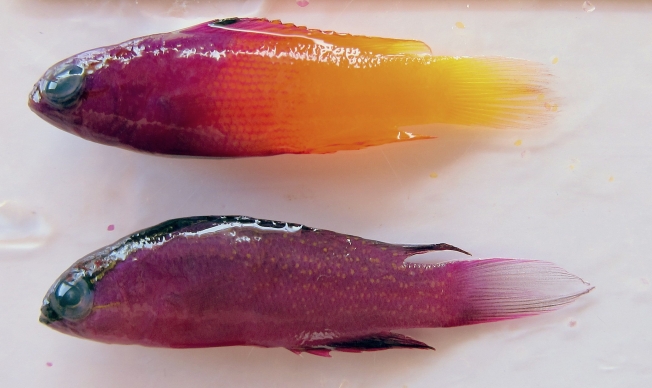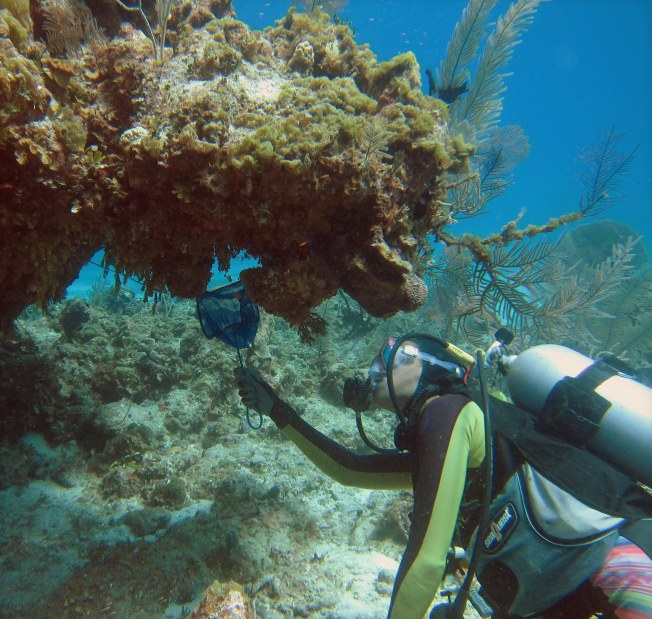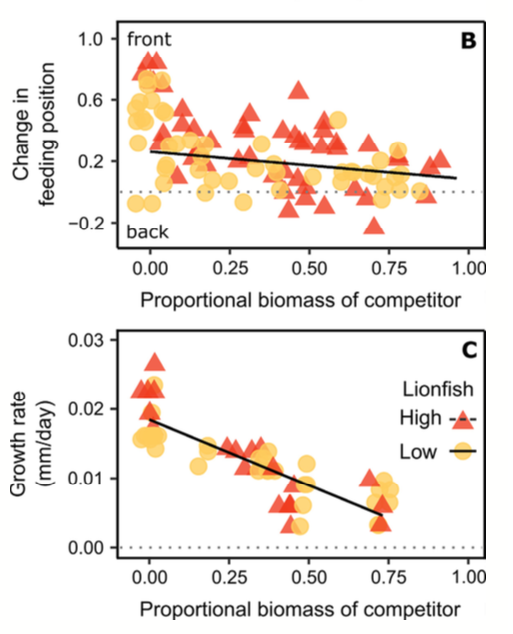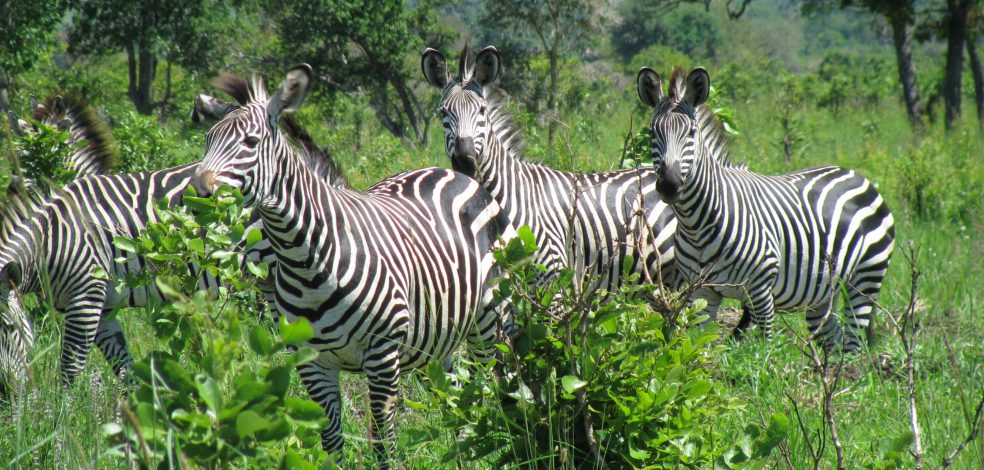I’m old enough to remember when ecological studies of invasive species were uncommon. Early on, there was a debate within the ecological community whether they should be called “invasive” (which conveyed to some people an aggressive image akin to a military invasion) or more dispassionately “exotic” or “introduced.” Lionfish (Pterois volitans), however, fit this more aggressive moniker. Native to the south Pacific and Indian Oceans, lionfish were first sighted in south Florida in 1985, and became established along the east Atlantic coast and Caribbean Islands by the early 2000s. They are active and voracious predators, consuming over 50 different species of prey in their newly-adopted habitat. Many population ecologists study the direct consumptive effects of invasive species such as lionfish. In some cases they find that an invasive species may deplete its prey population to very low levels, and even drive it to extinction.

A lionfish swims in a reef. Credit: Tye Kindinger
But things are not always that simple. Tye Kindinger realized that lionfish (or any predator that feeds on more than one species) could influence prey populations in several different ways. For the present study, Kindinger considered two different prey species – the fairy basslet (Gramma loreto) and the blackcap basslet (Gramma melacara). Both species feed primarily on zooplankton, with larger individuals monopolizing prime feeding locations at the front of reef ledges, while smaller individuals are forced to feed at the back of ledges where plankton are less abundant, and predators are more common. Thus there is intense competition both within and between these two species for food and habitat. Kindinger reasoned that if lionfish depleted one of these competing species more than the other, they could be indirectly benefiting the second species by releasing it from competition.

Fairy basslet (top) and blackcap basslet (bottom). Credit Tye Kindinger.
For her PhD research, Kindinger set up an experiment in which she manipulated both lionfish abundance and the abundance of each basslet species. She created high density and low density lionfish reefs by capturing most of the lionfish from one reef and transferring them to another (a total of three reefs of each density). She manipulated basslet density on each reef by removing either fairy or blackcap basslets from an isolated reef ledge within a particular reef. This experimental design allowed her to separate out the effects of predation by lionfish from the effects of competition between the two basslet species. Most of her results pertained to juveniles, which were about 2 cm long and favored by the lionfish.


Alex Davis captures and removes basslets beneath a ledge. Credit Tye Kindinger.
Kindinger measured basslet abundance in grams of basslet biomass per m2 of ledge area. When lionfish were abundant, juvenile fairy basslet abundance decreased over the eight weeks of the experiment (dashed line) but did not change when lionfish were rare (solid line). In contrast, juvenile blackcap basslet populations remained steady over the course of the study, whether lionfish were abundant or rare. Kindinger concluded that lionfish were eating more fairy basslets.

Abundance of juvenile fairy basslets (left) and blackcap basslets (right) as measured as change in overall biomass. Triangles represent high lionfish reefs and circles are low lionfish reefs.
Competition is intense between the two basslet species, and can affect feeding position and growth rate. Kindinger’s manipulations of lionfish density and basslet density demonstrate that fairy basslet foraging and growth depend primarily on the abundance of their blackcap competitors. When competitor blackcap basslets are common (approach a biomass value of 1.0 on the x-axis on the two graphs below), fairy basslets tend to move towards the back of the ledge, and grow more slowly. This occurs at both high and low lionfish densities.

Change in feeding position (top) and growth rate (bottom) of fairy basslets in relation to competitor (blackcap basslet) abundance (x-axis) and lionfish abundance (triangles = high, circles = low)
In contrast, blackcap basslets had an interactive response to fairy basslet and lionfish abundance. Let’s look first at low lionfish densities (circles in the graphs below). You can see that blackcap basslets tend to move towards the back of the ledge (poor feeding position) at high competitor (fairy basslet) biomass, and also grow very slowly. But when lionfish are common (triangles in the graphs below), blackcap basslets retain a favorable feeding position and grow quickly, even at high fairy basslet abundance.

Change in feeding position (top) and growth rate (bottom) of blackcap basslets in relation to competitor (fairy basslet) abundance (x-axis) and lionfish abundance (triangles = high, circles = low)
By preying primarily on fairy basslets, lionfish are changing the dynamics of competition between the two species. The diagram below nicely summarizes the process. Larger fish of both species forage near the front of the ledge, while smaller fish forage further back. But there is an even distribution of both species. Focusing on juveniles, they are relatively evenly distributed in the rear portion of the ledge (Figure B). When fairy basslets are removed experimentally, the juvenile blackcap basslets move to the front of the rear portion of the ledge, as they are released from competition with fairy basslets (Figure D). Finally, when lionfish are abundant, fairy basslets are eaten more frequently, and juvenile blackcaps benefit from the lack of competition (Figure F)

Kindinger was very surprised with the results of this study because she knew the lionfish were generalist predators that eat both basslet species, so she expected lionfish to have similar effects on both prey species. But they didn’t, and she does not know why. Do lionfish prefer to eat fairy basslets due to increased conspicuousness or higher activity levels, or are blackcap basslets better at escaping lionfish predators? Whatever the mechanism, this study highlights that indirect effects of predation by invasive species can influence prey populations in unexpected ways.
note: the paper that describes this research is from the journal Ecology. The reference is Kindinger, T. L. (2018). Invasive predator tips the balance of symmetrical competition between native coral‐reef fishes. Ecology, 99(4), 792-800. Thanks to the Ecological Society of America for allowing me to use figures from the paper. Copyright © 2018 by the Ecological Society of America. All rights reserved.
